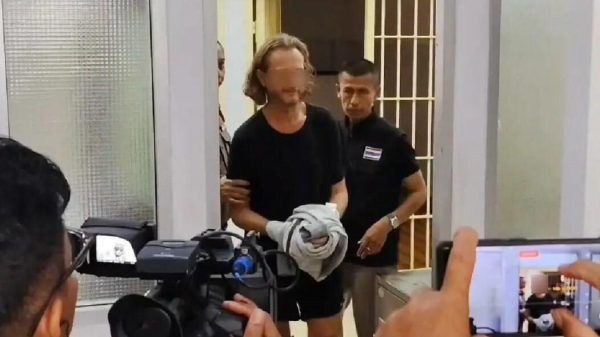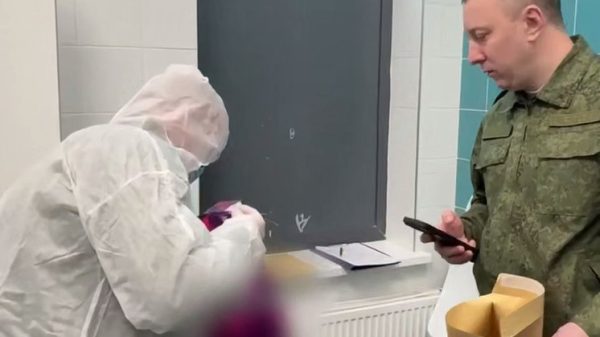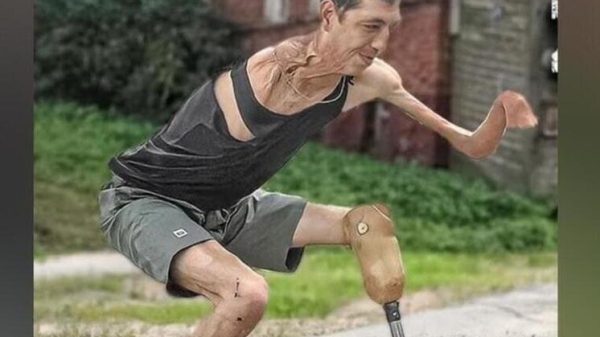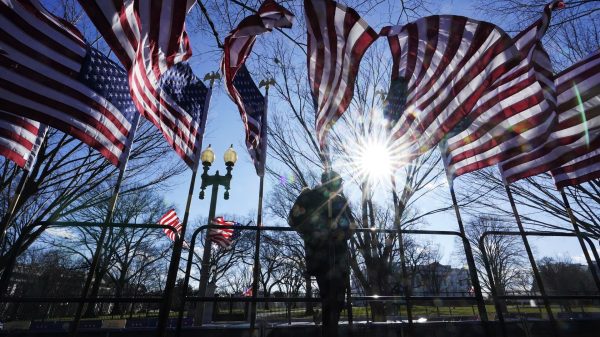
Acting Sergeant at Arms Timothy Blodgett, right, leads Rep. Jamie Raskin, D-Md., second from right, the lead Democratic House impeachment manager, and other impeachment managers, through the Rotunda to the Senate
Credit: AP
In the second impeachment trial of President Donald Trump, the prosecution rests. On Thursday night the third day of the historic hearings ended with Democratic senators wrapping up their argument that the former commander in chief must be held responsible for inciting an insurrection.
They did not come unprepared. To the surprise of many observers, prosecuting senators played video and audio that had not yet been made public, giving one of the most complete and comprehensive accounts yet of what happened on Capitol Hill on January 6.
The Democrats argued that Mr Trump had spent years courting and building up a fatalistic following; that he had spent most of 2020 casting doubt on the election and encouraging escalating violence and threats; that he did nothing to end the riot when it started and showed no remorse afterwards. If not impeached, they concluded, he or his future imitators could do it all again.
Yet with impeachment requiring a two-thirds vote of the entire US Senate, the Democrats’ bar for victory is very high. Here are the five big things we learned from their argument as we wait for Mr Trump’s own defence team to make his case on Friday.
1: The riot was a long time coming
Lacking direct evidence of Mr Trump’s motives, the prosecutors pinned their case on January’s violence being long-heralded and easily predictable. To build that case, they went way back into the history of Mr Trump’s public flirtations with violence, which go back to his campaign for the Republican nomination in 2015.
That year, he suggested a crowd at one of his rallies should "knock the hell out of" any protesters, adding: "I will pay for the legal fees, I promise." The prosecutors also cited Mr Trump’s diffident response to the murder of anti-fascist activist Heather Heyer in Charlottesville, Virginia in 2017.
One of the clearest examples came from this May when Mr Trump retweeted a video by Couy Griffin, founder of a group called Cowboys for Trump, in which Mr Griffin said "the only good Democrat is a dead Democrat". Later, Mr Griffin told CBS News: "It really means a lot to me because I know the POTUS has my back." He was present at the Capitol riot, and has been charged with unlawful entry (which he denies).
The prosecutors also argued that the groups and activists behind the Capitol riot had long signalled their capacity for violence, describing a similar invasion of the Michigan state capitol last April, and a later plot to kidnap Michigan’s governor Gretchen Whitmer.
There, again, they pointed to Mr Trump’s behaviour: he had tweeted "LIBERATE MICHIGAN" two weeks before the Capitol event, and responded to the plot against Ms Whitmer by criticising her for not saying "thank you" and reiterating his demand to "open up your state".
2: The storming was more violent than many had thought
It was already clear before the riot was finished that there had been violence, and within hours evidence emerged that some extremist groups had made detailed plans. Yet by assembling court documents, news video, rioters’ own social media content and brand-new security footage, the prosecutors laid out evidence that it could have been far worse.
There were startling images of senators Chuck Schumer and Mitt Romney nearly walking into the mob. Frantic police radio clips discussed rioters "throwing metal poles", causing "multiple injuries". Democrats showed video of rioters searching for House of Representatives speaker Nancy Pelosi, banging on a door where her staff were hidden, and quoted from FBI and other law enforcement documents saying that some had hoped to kill her.
In particular they focused on the Oath Keepers, a pro-Trump militia whose members now stand accused of conspiring to storm the building. Court documents describe one apparent leader, Jessica Watkins, as having "single-minded devotion to obstruct through violence", and of having "trained and plotted for a moment like this".
Mr Trump’s prosecution went all in, saying that some of the rioters genuinely planned to lynch members of the Senate.
3: Democrats hope to spark senators’ emotions
The footage played by the prosecutors was viscerally horrifying. Desperate screams and yells from police officers merged with pro-Trump chants and the din of hand to hand fighting. A hand reaches out and seizes the face of an officer’s gas mask, attempting to wrench it off.
The horror was the point. Prosecutors began their case with a 14-minute montage that was faintly reminiscent of a Paul Greengrass film, juxtaposing Mr Trump’s tweets and speeches with footage from the riots as well as clips from the Senate’s own debate that day.
At one point, Senator Eric Swalwell played video from a CCTV camera just behind the police line. It was silent, and the details of the battle were hard to discern. Then we switched to deafening, wildly disorienting body camera footage, watching from an officer’s perspective as they wrestled with a rioter for their baton being knocked to the ground. It was, in effect, a deft piece of cinematic editing.
"These people experienced trauma," said David Cicilline of his fellow senators and staff. "They were calling loved ones to say goodbye." He asked senators to "think of the people of this building when you cast this vote". The goal was seemingly to force senators to confront the very real terror of Jan 6, asking them in effect to vote for themselves as well.
It worked. The senators, writes Nick Allen, "sat riveted". Mr Romney said: "It tears at your heart and brings tears to your eyes." Democrat Dick Durbin said he had found it "emotionally difficult". Mr Trump’s defender, David Schoen, was less impressed, calling it an "entertainment package".
4: It won’t be easy to prove Trump was at fault
The Democrats’ greatest problem is that they have no direct evidence of Mr Trump’s mindset and intentions. They therefore relied much on Mr Trump’s history of violent rhetoric and on the large number of rioters who claimed to be following his instructions.
Some Republicans appeared swayed: Senator John Thune said prosecutors had "done a good job connecting the dots", while Lisa Murkowski said the evidence was "pretty damning". (Mr Romney remained a cool customer despite his close brush with the mob, saying he was "keeping an open mind".)
But most of their colleagues were far from convinced. "There was little said about [the] specific conduct of the president," said Ted Cruz.

Senator Ted Cruz, a Republican from Texas, center, speaks to members of the media at the U.S. Capitol in Washington
Credit: Bloomberg
"Nothing new here for me at the end of the day," said Josh Hawley. While both men have been key boosters of Mr Trump’s election hoax claims, they were not alone on this point.
Mr Trump’s lawyers have already jumped on this problem, with defender Bruce Castor saying he had not heard anyone say "they heard directly from President Trump". His colleague Mr Schoen said that Democrats "haven’t in any way tied it to Donald Trump".
According to reports, they plan to draw attention to Mr Trump’s call on Jan 6 for his supporters to "peacefully and patriotically make your voices heard". Democrats were criticised for initially ignoring the line, and had to integrate it into a later session.
Reportedly, they will also play video of Mr Schumer, a Democrat, using language just like Mr Trump’s, such as when he told the President’s Supreme Court appointee: "You have released the whirlwind, and you will pay the price. You won’t know what hit you if you go forward with these decisions."
5: The real battle may be for public opinion
The Democrats, of course, know that they will have a tough time winning the vote. Their strategy therefore seemed to have two audiences: not only senators but the American public, in whose eyes they sought to further toxify Mr Trump and to damn Republicans by association.
Forcing opponents to vote for something unpoopular is a time-honoured tradition of US politics. In polls just before Mr Trump’s term ended, 75pc of all American voters said Mr Trump bears "some" or "a lot" of responsibility for the riot; a narrower majority, 54pc, said it would be better for the country if he were forced from office.
Some Republicans believe the tactic has worked, with Ms Murkowski saying that, after seeing "the whole story laid out", she could not imagine "how Donald Trump could be re-elected to the presidency again". Former Trump adviser Peter Navarro said that on current showing "he’s going to lose this Super Bowl".
According to one report by CNN, even Mr Trump is concerned, and has been saying to advisers he might move on from his "Stop the Steal" campaign in order to escape the ghost of the riots. Then again, past example suggests that Mr Trump’s changes of heart rarely stick. As a different source put it: "Good luck with that!"



















































Свежие комментарии